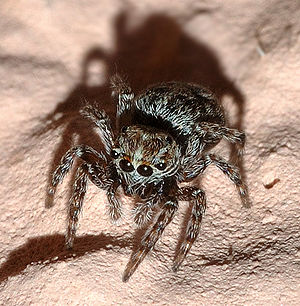Four point jumping spider
| Four point jumping spider | ||||||||||||
|---|---|---|---|---|---|---|---|---|---|---|---|---|

Four-point jumping spider female ( Sitticus pubescens ) |
||||||||||||
| Systematics | ||||||||||||
|
||||||||||||
| Scientific name | ||||||||||||
| Sitticus pubescens | ||||||||||||
| ( Fabricius , 1775) |
The four-point jumping spider ( Sitticus pubescens ) is a kind from the family of the jumping spiders (Salticidae).
description
The four-point jumping spider is 4 to 5 mm in size. Like the other species of the genus Sitticus , it has a compact body with a heart-shaped abdomen and eyes rimmed with orange. Identifying features of the species can be found in the drawing, which is largely the same in males and females, even if the males are a little darker in color. The top of the dark brown to black front body is covered with white hairs. These form a light triangle in front of the back eyes. On the abdomen, which is also dark, the hairs form a few pairs of symmetrically arranged light spots, which have given the species its German name.
Way of life
The four-point jumping spider can often be found near human habitation, on walls, fences, and wooden stakes, and occasionally inside houses. In the open air it prefers warm areas and stays there mostly on tree trunks, rocks and in quarries.
distribution
The species is distributed throughout Europe to the south of Scandinavia and England . It is quite common in the preferred habitats.
Four point jumping spider is of zebra spider captured
Web links
Sitticus pubescens in the World Spider Catalog
Individual evidence
- ↑ a b c Heiko Bellmann : Kosmos-Atlas arachnids of Europe . 2nd Edition. Kosmos-Verlag, 2001, ISBN 3-440-09071-X .
- ^ A b Michael J. Roberts : Spiders of Britain and Northern Europe . 1st edition. Collins Field Guide, 1996, ISBN 0-00-219981-5 (Over 450 Species).


